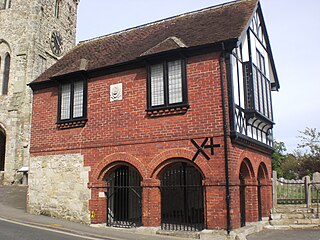
Tavistock Town Hall is a municipal building in Bedford Square, Tavistock, Devon, England. The structure, which remains the main venue for civic events in the town, is a Grade II listed building.

New Romney Town Hall is a municipal structure in the High Street, New Romney, Kent, England. The structure, which is the meeting place of New Romney Town Council, is a Grade II listed building.

Thornbury Town Hall, is a municipal building in the High Street, Thornbury, Gloucestershire, England. The building, which is the meeting place of Thornbury Town Council, is a Grade II listed building.

Queenborough Guildhall is a former municipal building in the High Street in Queenborough, Kent, England. The structure, which is currently used as a museum, is a Grade II listed building.

Garstang Town Hall is a municipal building in the High Street in Garstang, Lancashire, England. The structure, which currently accommodates two shops and a Royal British Legion Club, is a Grade II listed building.

Clun Town Hall is a municipal building in The Square in Clun, Shropshire, England. The building, which is now used as a museum, is a Grade II* listed building.

Malmesbury Town Hall is a municipal building in Cross Hayes in Malmesbury, Wiltshire, England. The structure, which is the meeting place of Malmesbury Town Council and the home of the Athelstan Museum, is a Grade II listed building.

Laugharne Town Hall is a municipal building in Market Street in Laugharne, Carmarthenshire, Wales. The structure, which is the meeting place of Laugharne Corporation, is a Grade II* listed building.

Crickhowell Market Hall, formerly Crickhowell Town Hall, is a municipal building in the High Street, Crickhowell, Powys, Wales. The structure, which accommodates market stalls on the ground floor and a café on the first floor, is a Grade II* listed building.

Corfe Castle Town Hall is a municipal building in West Street, Corfe Castle, Dorset, England. The town hall, which is currently used as a museum, is a Grade II* listed building.

Lostwithiel Guildhall is a municipal building in Fore Street in Lostwithiel, Cornwall, England. The structure, which currently accommodates the local museum, is a Grade II listed building.

Winchelsea Court Hall, formerly known as the Water Bailiff's Prison, is a municipal building in the High Street in Winchelsea, East Sussex, England. The structure, which is used as a museum, is a Grade I listed building.

Bangor Town Hall, formerly The Bishop's Palace, is a municipal building on Ffordd Deiniol, in Bangor, Gwynedd, Wales. The structure, which is now used as a museum, is a Grade II listed building.

Berkeley Town Hall is a municipal building in Salter Street, Berkeley, Gloucestershire, England. The structure, which is now used as a community events venue, is a Grade II listed building.

The Old Town Hall is a municipal building in the High Street, Brading, Isle of Wight, England. The structure, which is now used to store and exhibition a collection of artefacts and records, is a Grade II listed building.

Bradninch Guildhall is a municipal building in Fore Street, Bradninch, Devon, England. The structure, which is now used as a community events venue, is a Grade II listed building.

The Old Town Hall is a municipal building in the Market Place, Great Dunmow, Essex, England. The structure, which is now used as the offices of a firm of estate agents, is a Grade II listed building.

Kidwelly Town Hall is a municipal building in Lady Street, Kidwelly, Carmarthenshire, Wales. The structure, which was last used as a public library but is currently vacant, is a Grade II listed building.

St Clears Town Hall, is a municipal building in the High Street, St Clears, Carmarthenshire, Wales. The structure, which is currently disused, is a Grade II listed building.

St Davids City Hall, is a municipal building in the High Street, St Davids, Pembrokeshire, Wales. The structure is currently used as the meeting place of St Davids City Council and as a public library.





















